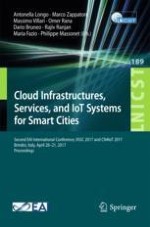2018 | Book
Cloud Infrastructures, Services, and IoT Systems for Smart Cities
Second EAI International Conference, IISSC 2017 and CN4IoT 2017, Brindisi, Italy, April 20–21, 2017, Proceedings
Editors: Antonella Longo, Marco Zappatore, Prof. Massimo Villari, Omer Rana, Prof. Dario Bruneo, Rajiv Ranjan, Dr. Maria Fazio, Philippe Massonet
Publisher: Springer International Publishing
Book Series : Lecture Notes of the Institute for Computer Sciences, Social Informatics and Telecommunications Engineering
